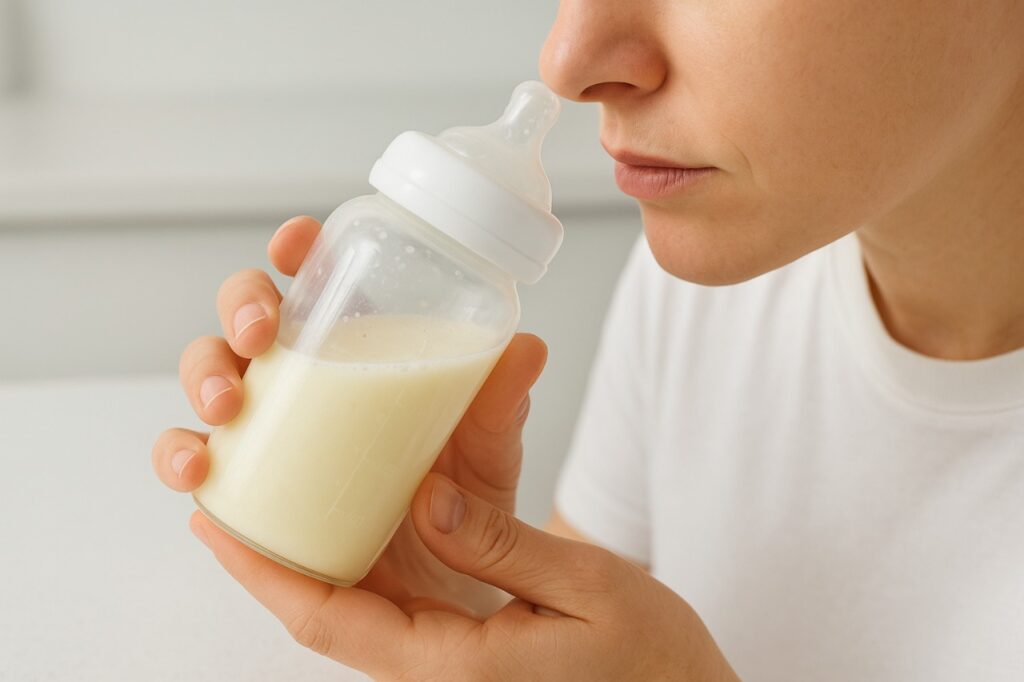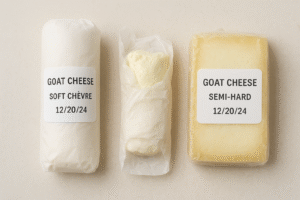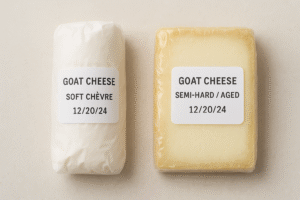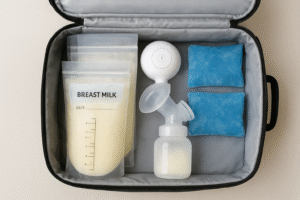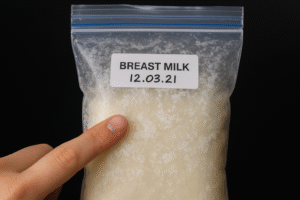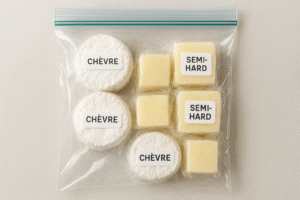Why Checking Breast Milk Freshness Matters
Every drop of breast milk is precious — it’s packed with nutrients, antibodies, and care. But like any natural liquid, breast milk can spoil if not stored or handled properly. Knowing when breast milk has gone bad helps keep your baby safe and ensures that every feeding delivers the nourishment it should.
In this guide, you’ll learn how to recognize spoiled milk by its look, smell, and texture — plus the key mistakes that can cause spoilage.
👉 For proper organization and freezing methods, check our detailed post How to Organize Breast Milk in Freezer (Flat-Freezing & FIFO Guide).
Visual Signs That Breast Milk Is Spoiled

It’s normal for stored milk to separate into layers — the creamy layer on top and the watery part below. However, if it doesn’t mix back together after gentle swirling or looks thick and curdled, it’s likely gone bad.
Warning signs include:
- Milk that appears chunky, clumpy, or sticky.
- A yellow-green or grayish tint (beyond the natural hue).
- Fat separation that won’t blend even after gentle mixing.
If you notice any of these, discard the milk immediately. Never shake vigorously; it can damage essential nutrients. Instead, gently swirl the container in a circular motion.
Smell Test: The Simplest Way to Detect Spoiled Milk
Fresh breast milk usually smells slightly sweet or clean. Some mothers’ milk may smell a bit soapy because of an enzyme called lipase — and that’s still safe.
But if the smell is sour, rotten, fishy, or metallic, the milk has spoiled and should not be used.
Quick tip: If your baby suddenly refuses milk they usually enjoy, it may have spoiled or oxidized.
👉 To learn how to safely warm milk without changing its smell, read Can You Reheat Breast Milk? (Safety & Best Practices 2025).
Texture and Taste Changes You Should Notice
Spoiled milk doesn’t just smell bad — it feels and tastes different.
- Normal milk: Smooth, light, and slightly sweet.
- Bad milk: Feels sticky, gritty, or clumpy, with a sour or bitter aftertaste.
If you ever have doubts, do a quick texture check before feeding. It’s better to discard questionable milk than risk your baby’s health.
How Long Stored or Thawed Milk Stays Fresh
Freshly expressed breast milk doesn’t last forever — its safety depends on temperature and storage conditions. Follow these general rules:
- At room temperature (up to 77°F / 25°C): Safe for about 4 hours.
- In a refrigerator (40°F / 4°C): Best within 4 days.
- In a freezer (0°F / -18°C): Stays fresh for 3–6 months.
- In a deep freezer (-4°F / -20°C): Can last up to 12 months.
- Once thawed (previously frozen): Use within 24 hours.
- Once reheated (already warmed once): Use within 2 hours.
Never refreeze thawed milk. Refreezing destroys antibodies and raises bacterial risk.
For clear, science-backed storage standards, review CDC’s Breast Milk Storage and Handling Guide.
Storage & Handling Mistakes That Cause Spoilage
Even properly pumped milk can spoil if handled carelessly. Here are the most common mistakes:
- Leaving milk out too long at room temperature.
- Placing bottles in the fridge door where temperatures fluctuate.
- Mixing warm and cold milk in the same bottle.
- Using unsterilized containers that introduce bacteria.
- Not labeling bottles with date and time.
If you’re unsure which materials are safest, see Best Non-Plastic Breast Milk Storage Solutions: Glass Jars, Silicone Bags, and Steel Containers (U.S. Guide 2025).
The Science Behind Off-Flavors: Understanding Lipase vs. Oxidation
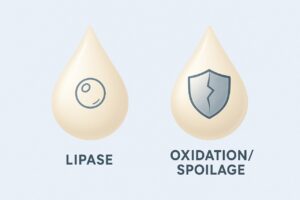
Sometimes, breast milk can smell or taste different even when it isn’t spoiled — and this usually happens due to lipase activity or oxidation.
- Lipase: A natural enzyme in breast milk that breaks down fats. It can give milk a mild soapy or sweet smell but remains completely safe for your baby.
- Oxidation: Occurs when milk is stored too long or exposed to excess air. It causes a metallic or bitter taste, often described as “off” or “old.”
The key difference:
- Lipase-related changes are safe and only affect smell or taste.
- Oxidation can indicate nutrient loss if milk has been kept for too long.
If your milk smells slightly metallic but your baby accepts it, there’s no harm. However, if it smells strong and your baby refuses it, consider refreshing your freezer stash and ensuring airtight storage.
This scientific distinction helps mothers recognize that not all “weird smells” mean milk is bad — sometimes, it’s just natural chemistry.
Why Breast Milk Spoils: The Science Behind It
Even though breast milk contains protective enzymes, temperature changes can accelerate spoilage.
- Bacteria growth occurs if milk stays warm for too long.
- Lipase enzyme breaks down fats and alters smell if stored too long.
- Oxidation causes nutrient loss and off-flavors.
According to Mayo Clinic’s Breast Milk Safety and Storage Guide, clean equipment, correct temperature, and prompt storage are the best ways to preserve freshness and nutrient value.
FAQ: Common Questions About Spoiled Breast Milk
Q1: Is sour-smelling milk always bad?
Not always — sometimes a mildly soapy smell is caused by natural lipase enzymes. But a strong sour, rancid, or fishy smell means it’s unsafe.
Q2: What if my baby accidentally drinks spoiled milk?
They may spit up, refuse feeding, or experience minor stomach upset. Offer water and monitor — contact a pediatrician if symptoms persist.
Q3: Can spoiled breast milk be reused for skincare?
No. Spoiled milk may contain harmful bacteria, so never use it for skin or baby products.
Q4: How can I prevent spoilage while traveling?
Use insulated cooler bags with ice packs and keep milk below 59°F (15°C). Read our travel-focused post How to Store Breast Milk on the Go.
Conclusion: Trust Your Senses and Storage Routine
Breast milk safety comes down to three things — proper storage, hygiene, and attention. If it smells bad, looks strange, or feels clumpy, trust your instincts and throw it away.
By following CDC and Mayo Clinic guidelines and maintaining consistent storage habits, you can keep every drop of milk safe and nourishing for your baby.

